Letters Home: Notes from a Forest Service nomad
I’ve been a nomad now for over thirty years, migrating every summer to the Rocky Mountains in Idaho to work for the United States Forest Service. My friends in the North Country wonder why I leave during the summer, the best time of the year in the Adirondacks, they say. And my friends in the West wonder why I don’t live in Idaho full time. It’s so beautiful here, they say.
I say it’s great to have friends on both sides of the country.
During my summer life I am rarely near civilization. When my kids were little my family lived on the top of Coolwater Ridge in a little glass lookout house where we paced the catwalk as we looked for forest fires. Now I work with my oldest son as a wilderness trail contractor in the Selway-Bitterroot Wilderness; work takes us far from the internet, roads and people.
The work sounds simple—clear the trees and rocks out of the trail – but nothing is completely simple in the wilderness. We are contracted to clear over a hundred miles of trail and have to carry all our food and tools on our backs. Sometimes the trees that fall down are large, or rip out the trail or pile up in great heaps. Motors are not allowed in federal wildernesses so we clear the trails with a five-foot two-person crosscut saw and double-bit axes and super sharp Silky handsaws. We never know what will be around the next corner, a long stretch of open trail or a big pile of trees.
At twenty-eight my son Lee is strong and able to carry an enormous pack. I’m slower but still good with the axe and the saw. Using a crosscut saw is about finesse, not strength. We know how to work together sawing out trees on hot, buggy days and days of pouring rain. This summer has been a challenge as a windy autumn and winter brought down many trees, especially lodgepole pine that have been killed by beetles or fire. Those hoped-for stretches of empty, clear trail have been rare.
But what keeps me coming back to this exhausting work is the land itself. We climb up to ridges that open up to panoramic views of the Bitterroot Mountains. We clear the trail to alpine lakes where we plunge in the cold water to wash off before eating our crackers and cheese for lunch. We watch hoary marmots sunning themselves in rock piles, big lazy mammals who seem to me like terrestrial seals or walruses. We lift big rocks out of the trails, rocks that black bear have flipped over as they look for ants. Each day is an adventure, even the discouraging ones where we make almost no miles because of the piles of trees we have to cut out.
I’m in Missoula, Montana now, using the free wifi at the Green Hanger Laundromat. Tomorrow we head back into the woods and will carry ten days of dry food as we cut our way toward Big Sand Lake and the pass that leads from Idaho into Montana. We’ll carry our tools, of course, but also each of us will have a carefully chosen book, often a classic in a cheap edition—thin, yellowed pages with tiny words— to get the most sentences per ounce. Lee read a Gertrude Stein book last week while I got most of the way through A Death in the Family by James Agee. At the end of a long day we make camp, cook dinner and then crawl into the tent to read. It is such a pleasure to read the words of a master writer and to not have the distraction of other books, or magazines or the internet.
Now that it’s August in this dry part of the Rockies forest fires add another element of chance to our work. Because of a big fire south of Missoula we can’t hike in to our trails via the Blodgett Pass Trail. Another fire near Elk Summit, where two or our trails begin, threatens to close the road. We’ll leave a key hidden on the car when we park at the Elk Summit campground. If the fire gets close to the road, the fire crew will drive our car down to a safer location. When we hike out we’ll be escorted through the burned area in a Forest Service truck.
It sounds exciting, and it is, but most of the time the work is calm and repetitive. Wilderness areas are meant to be “untrammeled by man.” Our work is quiet and we leave little trace, except the smooth white interiors of the just-cut trees.





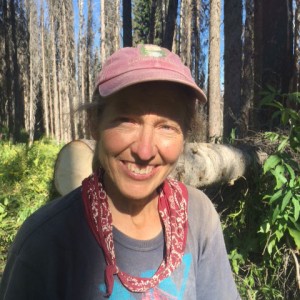
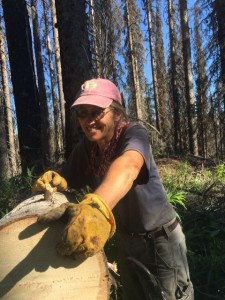
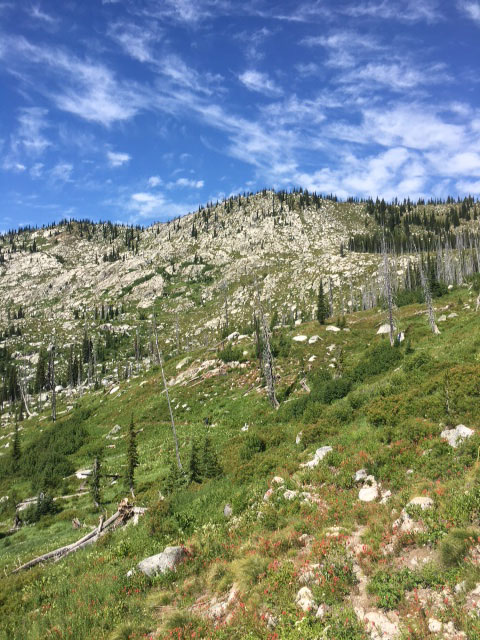
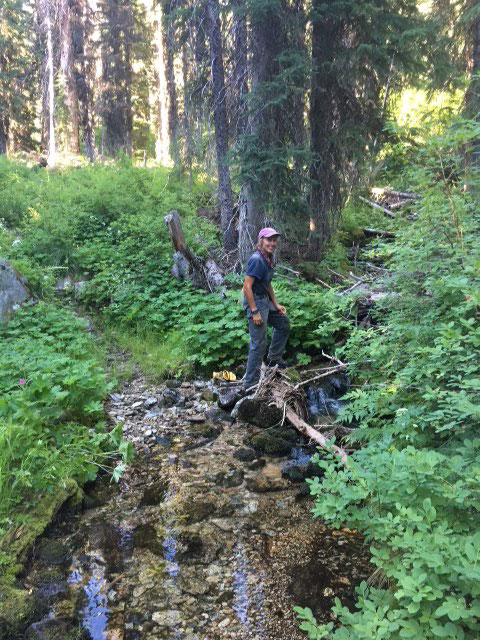
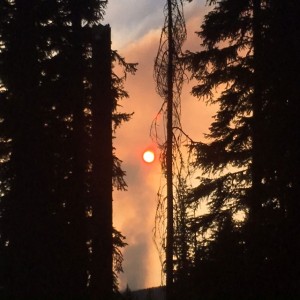



wow, Betsy, we’re inspired by all your physical work activities. sleeping in a tent all summer would eliminate us! J&ME
Many years ago I spent time in the National Forest by the middle fork of the Salmon River near Salmon Idaho. The dry west forests smell and feel differently from our wet forest of the Adirondacks. And the minerals and rocks are so much more diverse and actually beautiful.